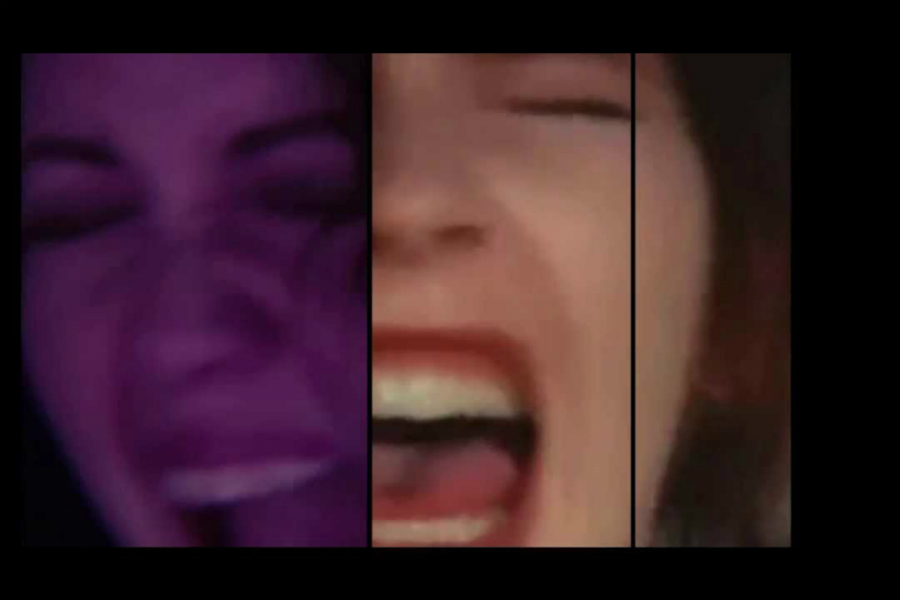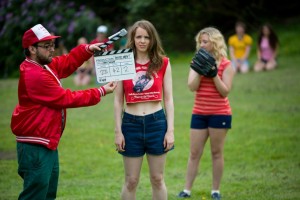Jamie Shovlin’s Hiker Meat — Reviewed

Hoaxes, exploitation and monsters: Lauren Velvick explores Jamie Shovlin’s latest exhibition and discovers a pervading sense of giddiness…
Jamie Shovlin’s Hiker Meat explores the labour of, and mythology surrounding, low budget or amateur filmmaking, with a focus on exploitation cinema. The exhibition centres on a mysterious horror film that is introduced in Gallery One through a display in the style of an old fashioned media museum, offering clues in the form of promotional artwork and gruesome props from the film, along with text panels detailing a catalogue of troubles during production.
Whilst some of Shovlin’s previous works have been hoaxes, where the audience is deceived for at least part of the time, here we are informed that Hiker Meat is a fake film from the outset, and so can approach the exhibition knowingly.
The selection of props, posters and footage shown in Gallery One are intriguing, and relate a confusing and at times humorously disturbing tale. That these items are presented as ‘real’ invites the viewer to become immersed in the story, with wry details like the band Lustfaust, who supposedly recorded the soundtrack for Hiker Meat, and are playing through ‘aged’ footage on a monitor. Taken on its own the display here is basically fun and curious, bringing to mind avid fans and collectors excavating rare footage and paraphernalia. However, there is a dual focus here: as well as Hiker Meat, an important part of this exhibition is the accompanying documentary, Rough Cut.
This second film, screened separately to the exhibition, follows the adventures of various Cornerhouse staff, filmmakers, artists and actors, as they re-make key scenes from Hiker Meat — which have been chosen for their familiarity as horror cliches.
As Bren O’Callaghan, Visual Arts Programmer at Cornerhouse, explained: “Jamie watched hundreds of exploitation films from the late ’70s to early ’80s and cannibalised them, and cut them up taking very standard scenes, and sewed them back together creating a prototype of the full Hiker Meat film — and that’s the closest Hiker Meat will ever come to existing, as a 90 minute prototype”.

Shovlin’s collage of clips was made to the specifications of collaborator Mike Harte’s three hundred word synopsis, written several years ago as part of their earlier ‘Lustfaust’ project (the band from Gallery One). Upstairs in Gallery Two there is a mixture of material relating to Hiker Meat and to Rough Cut, introducing the documentary as a further part of the fabricated lore surrounding the film.
As with many of Cornerhouse’s exhibitions, in Hiker Meat the viewer is required to (or at least has the option of) spending time sitting, watching and listening, and here the filmic displays are presented in a way that encourages the viewer to split their attention between two scenes at once, or to try and spot the difference. This creates a muddled kind of viewing experience, and harks back to the first gallery space where the repeated re-filming and replacement of scenes is described on the wall panels.
Within the narrative of the show, the viewer traverses an adjustment from voluntary suspension of disbelief to being told another, verifiably real story of low budget filmmaking. In Gallery Three the detailed planning behind Rough Cut is presented as a great circular drum of chalkboard filled with details and directions that cannot possibly all be read, whilst stacked television screens playing a different talking head on each give perspectives on the making of the film.
This section of installation represents the ‘working out’, according to O’Callaghan; “It’s not dissimilar to a praxiscope – you almost feel dizzy standing in the centre of the overwhelming amount of information…it sort of spins you around and then spits you back out”.
Each of the three floors over which Hiker Meat is displayed offers a different perspective on filmmaking, as well as raising issues around how far and in what circumstances we are willing to suspend disbelief. The type of filmmaking explored is poignant in this respect; O’Callaghan defines exploitation films as “an approach, [it's] really just another term for low budget, for instance exploitation documentaries which are poorly made, highly subjective and one sided”; and situates the exhibition as an exercise in, or exploration of storytelling. ”One reaction could be that it is just an elaborate deception, but on the other hand when you’re reading a novel you’re not questioning whether it’s real…you can turn away, or you can decide that it’s believable enough for you to fill in the gaps.”
The enthusiasm and dedication of the imagined and real protagonists invigorate this exhibition; whether it is the fictional director of Hiker Meat, Jesus Rinzoli, or the special effects technician who built a monster with loft insulation, latex and powdered lubricant. The sense of giddiness that comes with taking on an overly ambitious collaborative project pervades, and adds a layer of emotional interest to an exhibition that could seem too much like a puzzle.
Lauren Velvick
Hiker Meat continues at Cornerhouse, Manchester, until Monday 21 April 2014, free entry





